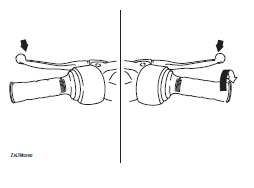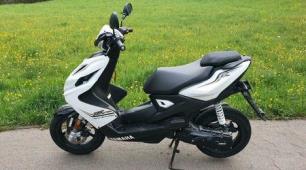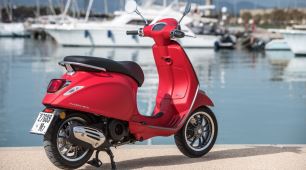 Yamaha aerox NS50 - Owner's Manual > Braking
Yamaha aerox NS50 - Owner's Manual > Braking
WARNING
- Avoid braking hard or suddenly (especially when leaning over to one side), otherwise the scooter may skid or overturn.
- Railroad crossings, streetcar rails, iron plates on road construction sites, and manhole covers become extremely slippery when wet. Therefore, slow down when approaching such areas and cross them with caution.
- Keep in mind that braking on a wet road is much more difficult.
- Ride slowly down a hill, as braking downhill can be very difficult.
1. Close the throttle completely.
2. Apply both front and rear brakes simultaneously while gradually increasing the pressure.

Tips for reducing fuel consumption
Fuel consumption depends largely on your riding style. Consider the following tips to reduce fuel consumption:
- Avoid high engine speeds during acceleration.
- Avoid high engine speeds with no load on the engine.
- Turn the engine off instead of letting it idle for an extended length of time (e.g., in traffic jams, at traffic lights or at railroad crossings).
Engine break-in
There is never a more important period in the life of your engine than the period between 0 and 1000 km (600 mi). For this reason, you should read the following material carefully.
Since the engine is brand new, do not put an excessive load on it for the first 1000 km (600 mi). The various parts in the engine wear and polish themselves to the correct operating clearances.
During this period, prolonged full-throttle operation or any condition that might result in engine overheating must be avoided.
0-150 km (0-90 mi)
Avoid prolonged operation above 1/3 throttle. Vary the speed of the scooter from time to time. Do not operate it at one set throttle position.
150-500 km (90-300 mi)
Avoid prolonged operation above 1/2 throttle.
500-1000 km (300-600 mi)
Avoid cruising speeds in excess of 3/4 throttle.
1000 km (600 mi) and beyond
Avoid prolonged full throttle operation.
Vary speeds occasionally. NOTICE: After 1000 km (600 mi) of operation, the final transmission oil must be changed.
NOTICE
If any engine trouble should occur during the engine break-in period, immediately have a Yamaha dealer check the vehicle.
Parking
When parking, stop the engine, and then remove the key from the main switch.
WARNING
- Since the engine and exhaust system can become very hot, park in a place where pedestrians or children are not likely to touch them and be burned.
- Do not park on a slope or on soft ground, otherwise the vehicle may overturn, increasing the risk of a fuel leak and fire.
- Do not park near grass or other flammable materials which might catch fire.
See also:
 Yamaha aerox NS50 - Owner's Manual > Starting a cold engine
Yamaha aerox NS50 - Owner's Manual > Starting a cold engine
NOTICE For engine break-in instructions prior to operating the vehicle for the first time. 1. Turn the key to " ".
 Yamaha aerox NS50 - Owner's Manual > Periodic maintenance and Adjustment
Yamaha aerox NS50 - Owner's Manual > Periodic maintenance and Adjustment
Periodic inspection, adjustment, and lubrication will keep your vehicle in the safest and most efficient condition possible. Safety is an obligation of the vehicle owner/operator. The most important points of vehicle inspection, adjustment, and lubrication are explained on the following pages.
 BMW R 1250 RT
BMW R 1250 RT Kymco Agility 50
Kymco Agility 50 Piaggio Liberty 50
Piaggio Liberty 50 Yamaha aerox NS50
Yamaha aerox NS50 Aprilia SR50R
Aprilia SR50R Kymco Agility 50
Kymco Agility 50 Vespa Primavera 50
Vespa Primavera 50 Peugeot Speedfight
Peugeot Speedfight